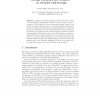Free Online Productivity Tools
i2Speak
i2Symbol
i2OCR
iTex2Img
iWeb2Print
iWeb2Shot
i2Type
iPdf2Split
iPdf2Merge
i2Bopomofo
i2Arabic
i2Style
i2Image
i2PDF
iLatex2Rtf
Sci2ools
SLS
2007
Springer
2007
Springer
Designing and Tuning SLS Through Animation and Graphics: An Extended Walk-Through
Stochastic Local Search (SLS) is quite effective for a variety of Combinatorial (Optimization) Problems (COP). However, the performance of SLS depends on several factors and getting it right is not trivial. In practice, SLS may have to be carefully designed and tuned to give good results. Often this is done in an ad-hoc fashion. One approach to this issue is black-box where a tuning algorithm is used to find good parameters for the black-box SLS. Another approach is white-box which takes advantage of the human in the process. In this paper, we show how visualization using a generic visual tool can be effective for a white-box approach to get the right SLS behavior on the fitness landscape of the problem instances at hand. We illustrate this by means of an extended walk-through on the Quadratic Assignment Problem. At the same time, we present the human-centric tool which have been developed.
| Added | 09 Jun 2010 |
| Updated | 09 Jun 2010 |
| Type | Conference |
| Year | 2007 |
| Where | SLS |
| Authors | Steven Halim, Roland H. C. Yap |
Comments (0)

